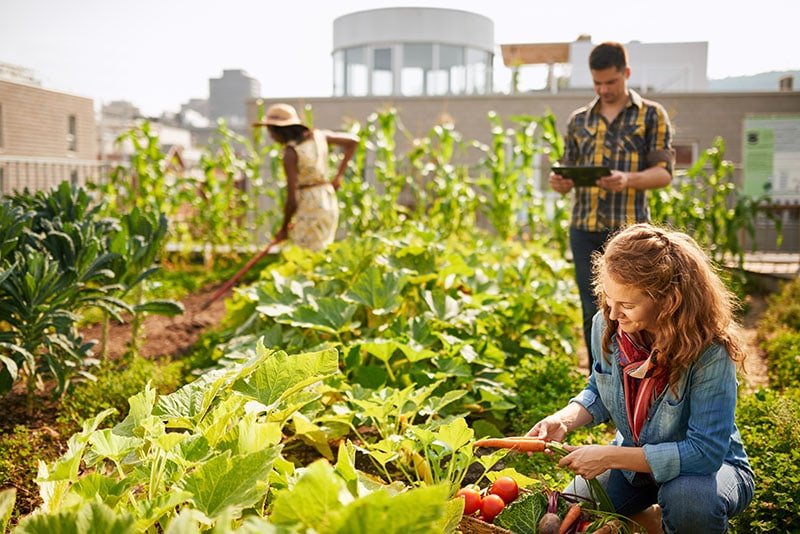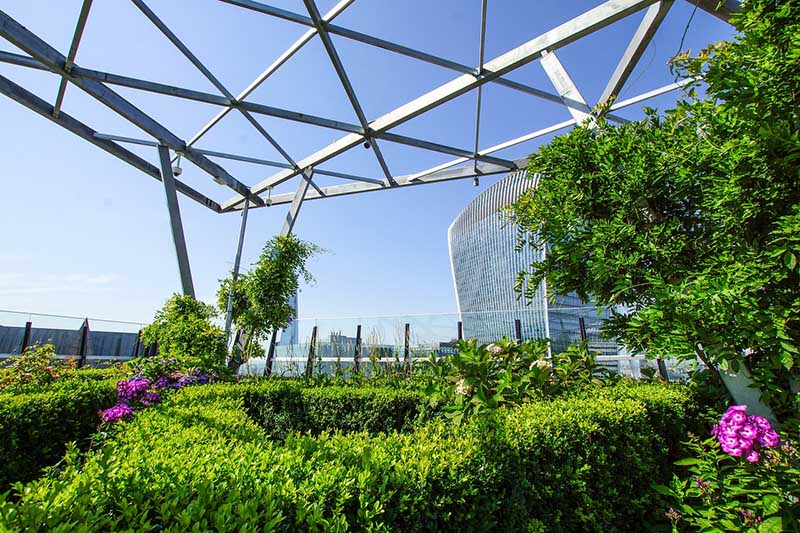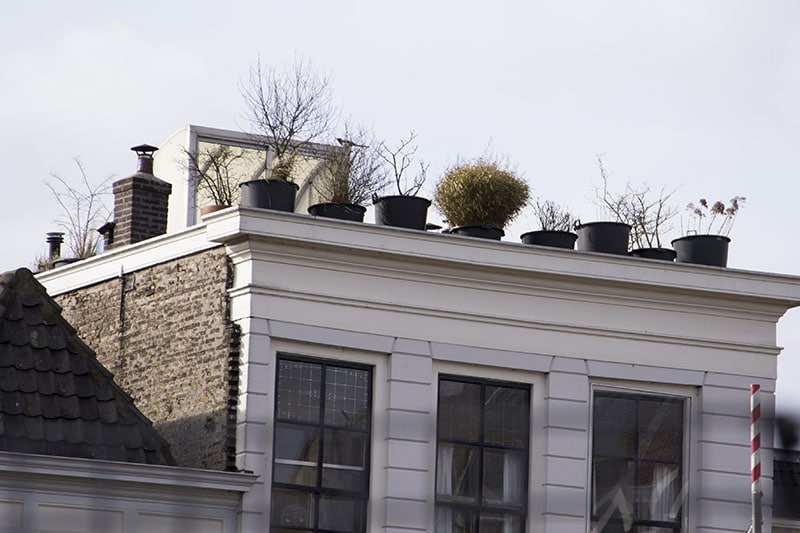Rooftop Gardens: Advantages and Disadvantages 2025 Guide
-

- Last updated:

While most of us are familiar with the common roofing structures like solar, metal, or shingles, there is an eco-friendly alternative that is becoming a popular trend over traditional roofing materials. Green roofs are becoming more popular due to their durability, lifespan, and aesthetics.
If you are intrigued by the thought of designing a rooftop garden, here is some information that you may find helpful. There are three types of green roofs, and all of them have advantages and disadvantages. And in some instances, they may not be a suitable alternative for your structure or budget.
How Does It Work?
A rooftop garden is a manufactured garden space that consists of plants like trees and shrubs. They can be designed for the sole purpose of managing stormwater, creating an area to play or relax, or providing an area for growing flowers. In urban areas where there may not be sufficient land available for planting, residents can use rooftop gardens to plant herbs and vegetables. There are three types of rooftop gardens and each of them have specific features and purpose.

What Are the Different Types of Rooftop Gardens?
There are three main types of rooftop gardens. The type of garden on a residential or commercial structure will depend on the purpose of the garden and what features will be included in the space.
Extensive
An extensive green roof consists of vegetation that is limited to mosses, herbs, sedums, flowers, small plants, succulents, and desert grasses. An extensive green roof is a low-maintenance garden that has a lightweight, thin growing medium of about three to six inches.
This type of garden is ideal for managing stormwater on residential homes with low-sloped or flat roofs. Extensive rooftop gardens are usually cost-efficient and easy to install. This type of rooftop garden is non-accessible, however.
Intensive
A intensive green roof consists of large and small plants, like ground cover, trees, and shrubs. Intensive rooftop gardens are creatively designed to support anything from sky parks to vegetable gardens to playgrounds. This type of garden contains deep soil with a growing medium of over six inches and requires professional maintenance.
Since they are made to support a significant amount of weight and require the installation of an irrigation system, they are mainly found on commercial buildings and are accessible to people.
Semi-Intensive
A semi-intensive green roof consists of a mix of vegetation and design somewhere between intensive and extensive green roofs. The growing medium is about six to twelve inches and can support grasses, ground cover, small plants, herbs, and shrubs. They require moderate maintenance and occasional watering. The Semi-intensive green roof is accessible to people and ideal for providing play areas in daycares, urban picnic areas, and a garden design for long-term care facilities.
Where Is It Used?
Due to the congestion and lack of green space in urban areas, more architects and homeowners are developing rooftop gardens to provide a place for growing plants and add beauty to commercial and residential structures.
Rooftop gardens are becoming more popular in commercial buildings, industrial buildings, and residential structures. They provide shelter, shade, and play space. In some instances, they are designed to create a green living area or a place to grow produce.

Advantages of a Rooftop Garden
In addition to the aesthetics, here are some of the health and environmental advantages of having a rooftop garden.
- Noise Reduction: While growing medium on a garden roof will prevent low-frequency sounds, like severe weather, the garden plants can help to limit the noise from high-frequency sounds.
- Insulation: The insulation provided by the layers of your rooftop garden will help to reduce energy costs by keeping the structure warm in the cold months and cool in the summer months.
- Eco-Friendly: Plants provide an increase of oxygen for our environment.
- Regulates Temperature: Rooftop gardens eliminate the need for reflective materials like marble, glass, and stone. The plants help the water to evaporate, which cools the outside of the structure and reduces the temperature in the surrounding area.
- Wildlife: Green roofs provide a habitat for wildlife like insects, birds, and other animals.
- Improves Emotional Health: A green roof provides residents with an aesthetically pleasing environment which can improve mood and emotional health.
- Produce: Roof gardens provide a place for residents to grow vegetables and herbs in areas where there may not be an area sufficient for gardening.
Disadvantages of a Rooftop Garden
Although rooftop gardens have their advantages, here are some of the disadvantages.
- Maintenance: The amount of maintenance for a rooftop garden depends on the design and type of plants you add to the structure. If you create an environment of low-water plants, the maintenance requirements will be minimal. Although, there may be times when you will need to add or replace growing media or add plants to the garden.
- Wind: In some instances, the growing media on the roof can get blown away during strong windstorms. There are mesh coverings made specifically for preventing soil loss, however.
- Weight: Roof gardens put a significant amount of weight on your roof system. A roof garden can weigh from under two hundred pounds per square to upwards of one thousand pounds per square. You must install the proper support for your roof garden.
- Repairs: Unfortunately, if the rooftop garden is not installed properly, it can begin to leak and will need to be repaired. The process requires removing layers to find the leak and can be time-consuming.

Frequently Asked Questions (FAQs)
What is the cost of a rooftop garden?
No matter what type of rooftop garden you choose, you will need to make a significant investment. The cost of a green roof ranges between $15 and $30 per square foot. Some more extravagant designs can cost up to $200 plus per square foot.
What do I look for in a rooftop garden contractor?
Be sure to hire a contractor that specializes in rooftop gardens. They should possess in-depth knowledge and experience in designing a rooftop garden that will thrive and grow in your specific area. The candidate should be experienced in designing landscapes and can foresee any potential problems. They should have in-depth knowledge of what is involved in the job.
Can I create a rooftop garden myself?
For the DIYer who wants to create a rooftop garden with some container plants, you should have no issue doing it yourself. However, for residential and commercial property owners looking to create a rooftop garden that increases the value of the property and has environmental benefits, we recommend hiring a professional landscape design contractor who is experienced in the field of rooftop gardens. This is especially true for complex designs on commercial buildings.
What are the maintenance requirements for a rooftop garden?
The care and maintenance required on a rooftop garden will depend on the type (intensive, extensive, semi-intensive) you have installed on your home or building. An extensive garden installed on your home may require inspection every six months, while an intensive garden on a commercial property will require regular weekly inspections, especially in the summertime. The roof and gutter checks on intensive gardens should be done at least twice a year.
What is the lifespan of a green roof?
A green roof that is well maintained and properly installed should last from 30 to 50 years. That is two to three times the lifespan of other typical roofs.
Can a rooftop garden be installed on an existing structure?
Provided that the weight-bearing capacity of the existing structure is inspected and approved by a structural engineer, a rooftop garden can be installed on an existing home or building. The waterproofing material must be in top-notch condition and no more than five years old. The best time to install a garden on your roof is when your old roof needs to be replaced. That way, you can install new waterproofing and set up a system to detect future leaks.
Do green roofs need to be mowed?
Typically, green roofs are created with plants that require little watering and maintenance. If you plant grass on your roof, you will need to mow it, however.
Conclusion
Installing a rooftop garden on your home or building is an eco-friendly alternative to traditional roofs. However, there are several things to consider, like cost and structure. It is recommended that you get the advice of a professional so your garden fits your lifestyle, budget, and purpose.
- You might also like: 8 Great Greenhouse Flooring Types (with Pictures)
Featured Image Credit: AYA images, Shutterstock
Contents

